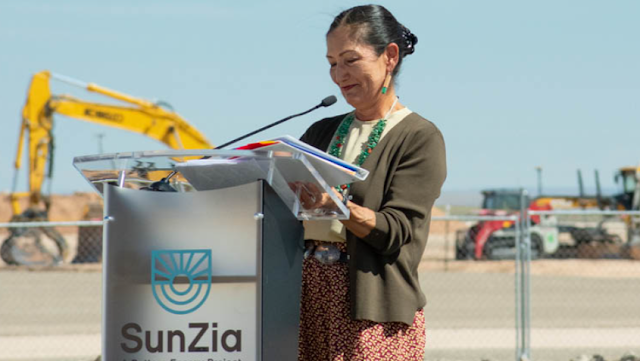Interior Secretary Deb Haaland speaking during the groundbreaking ceremony for SunZia transmission line project in Corona, New Mexico in 2023.
The SAN CARLOS APACHE TRIBE AND TOHONO O’ODHAM NATION APPEAL FEDERAL COURT RULING DENYING INJUNCTION TO STOP CONSTRUCTION OF THE SUNZIA TRANSMISSION PROJECT
Statement by Tohono O'odham and San Carlos Apache Nations
Censored News
April 29,204
TUCSON, Arizona -- The San Carlos Apache Tribe and the Tohono O’odham Nation on April 24, 2024 appealed a Tucson federal court’s April 16, 2024, decision that denied the Tribes’ request for a preliminary injunction to stop construction of the SunZia Transmission Project through 50 miles of the San Pedro River Valley.
The Tribes are requesting the court to rule on their appeal as soon as possible because ongoing construction of roads and power line infrastructure is inflicting severe damage on a culturally intact landscape that has evidence of human activity dating back 12,000 years.
“Power line construction has already altered an area of significant historic, cultural and religious value to the Tribes,” San Carlos Apache Chairman Terry Rambler said. “We urge the court to reconsider its decision that is resulting in permanent and unnecessary harm to our ancestral lands in the San Pedro River Valley.”
“The federal court decision is based on an improper application of a statute of limitations that should not apply in this case,” said Tohono O’odham Nation Chairman Verlon Jose. “The irreparable harm to historically and culturally significant places on our ancestral lands needs to be stopped immediately.”
The U.S. Bureau of Land Management (BLM) agreed to meet its obligations under the National Historic Preservation Act (NHPA) to analyze the cultural and historic impacts of the SunZia project after it issued a Record of Decision (ROD) approving the power line routing in 2015 under the National Environmental Policy Act. (NEPA). The BLM has yet to complete the historic and cultural analysis required under NHPA. The Tucson district court, however, ruled that a six-year statute of limitations to appeal the power line routing began after the issuance of the ROD in 2015.
“This raises a serious and exceptionally important issue for appellate review concerning when the statute of limitations begins to run on challenges to the BLM’s failure to comply with NHPA obligations where the BLM separated the NEPA and NHPA processes,” Chairman Jose said.
There are alternative routes through existing power line corridors in Arizona available for the SunZia Transmission Project that would leave the San Pedro River Valley intact.
“We will continue to oppose this environmentally and culturally irresponsible project that could easily be rerouted through already degraded power line corridors rather than destroying this irreplaceable stretch of the San Pedro River Valley,” Chairman Rambler said.
The Tribes are requesting the court to rule on their appeal as soon as possible because ongoing construction of roads and power line infrastructure is inflicting severe damage on a culturally intact landscape that has evidence of human activity dating back 12,000 years.
“Power line construction has already altered an area of significant historic, cultural and religious value to the Tribes,” San Carlos Apache Chairman Terry Rambler said. “We urge the court to reconsider its decision that is resulting in permanent and unnecessary harm to our ancestral lands in the San Pedro River Valley.”
“The federal court decision is based on an improper application of a statute of limitations that should not apply in this case,” said Tohono O’odham Nation Chairman Verlon Jose. “The irreparable harm to historically and culturally significant places on our ancestral lands needs to be stopped immediately.”
The U.S. Bureau of Land Management (BLM) agreed to meet its obligations under the National Historic Preservation Act (NHPA) to analyze the cultural and historic impacts of the SunZia project after it issued a Record of Decision (ROD) approving the power line routing in 2015 under the National Environmental Policy Act. (NEPA). The BLM has yet to complete the historic and cultural analysis required under NHPA. The Tucson district court, however, ruled that a six-year statute of limitations to appeal the power line routing began after the issuance of the ROD in 2015.
“This raises a serious and exceptionally important issue for appellate review concerning when the statute of limitations begins to run on challenges to the BLM’s failure to comply with NHPA obligations where the BLM separated the NEPA and NHPA processes,” Chairman Jose said.
There are alternative routes through existing power line corridors in Arizona available for the SunZia Transmission Project that would leave the San Pedro River Valley intact.
“We will continue to oppose this environmentally and culturally irresponsible project that could easily be rerouted through already degraded power line corridors rather than destroying this irreplaceable stretch of the San Pedro River Valley,” Chairman Rambler said.


No comments:
Post a Comment